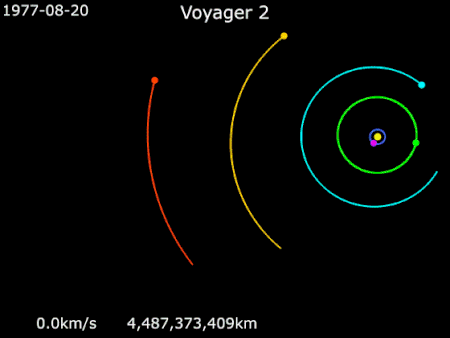Black Hole Gravity Assists
Background

Exploration missions within the solar system often employ a technique known as gravity assists from celestial bodies to modify a spacecraft's trajectory without expending propellant. During this process, the spacecraft approaches a nearby celestial body, such as a planet or moon, closely enough to be influenced by its gravitational pull. This gravitational interaction allows for adjustments not only in the spacecraft's direction but also in its velocity. Specifically, the spacecraft can actually increase its velocity through this maneuver by effectively harnessing some of the kinetic energy of the assisting body. It's akin to 'stealing' momentum from the celestial body to propel the spacecraft forward.
Prominent examples of gravity assists utilized in solar system exploration are exemplified by the trajectories of the Voyager spacecraft. Illustrated in Figure 1 is the trajectory of Voyager 2, showcasing notable gravity assists from the massive planets Jupiter, Saturn, and Uranus. These planets, with their significant gravitational fields and abundant kinetic energy, play pivotal roles in shaping the spacecraft's path. More recently, during its decade-long journey to Comet 67P/Churyumov-Gerasimenko, the European Space Agency's (ESA) Rosetta spacecraft employed gravity assists to great effect. Rosetta executed one gravity assist maneuver around Mars in 2007 and three additional assists around Earth in 2005, 2007, and 2009 [1]. These maneuvers effectively utilized the gravitational pull of celestial bodies to optimize the spacecraft's trajectory and conserve fuel.
Project overview
We are currently exploring the concept of utilizing gravity assists from black holes and neutron stars. The condensed nature of these celestial bodies allows a spacecraft to penetrate deeper into the gravitational field than would be possible with planets or stars, resulting in exceptionally efficient gravity assists. However, because of the intense accelerations exerted by these objects, traditional Newtonian physics is inadequate for planning such maneuvers. Instead, Einstein's theory of general relativity must be employed. Drawing from established frameworks [2], we are examining the practicality of employing gravity assists from compact objects for future interstellar travel. Key areas of focus include comparing the efficiency of relativistic versus Newtonian gravity assists, identifying new effects, and analyzing the associated trade-offs from a mission perspective.
References
[1] https://www.esa.int/Science_Exploration/Space_Science/Rosetta/The_long_trek
[2] Zhang, F. Gravitational slingshots around black holes in a binary. Eur. Phys. J. Plus 135, 104 (2020). https://doi.org/10.1140/epjp/s13360-020-00157-6